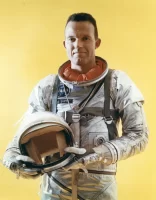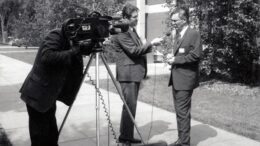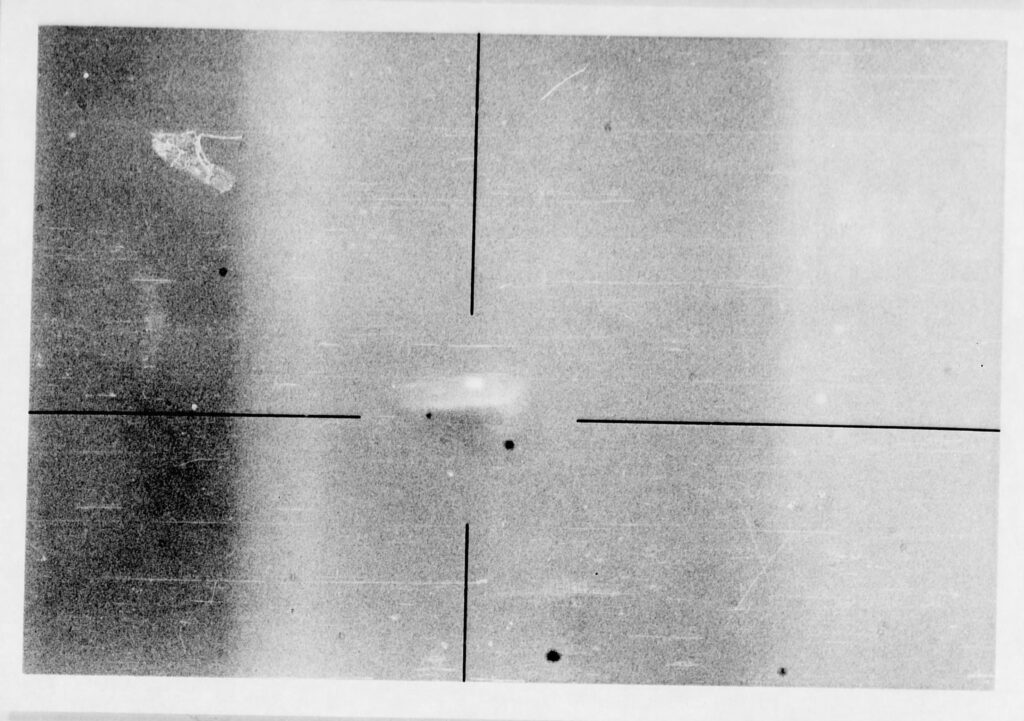 by Charles Lear, author of “The Flying Saucer Investigators.”
by Charles Lear, author of “The Flying Saucer Investigators.”
Gordon Cooper, youngest of the original Mercury astronauts, often spoke publicly about his UFO sightings and beliefs. He appeared in documentaries such as James Fox’s 2003 film Out of the Blue, and famously wrote a letter dated November 9, 1978, to Ambassador of Grenada to the United States George Ashley Griffith calling for the scientific collection and analysis of data taken from UFO encounters in order to “determine how best to interface with these visitors in a friendly fashion.” In Out of the Blue, he is heard telling a story about a flying saucer with three retractable legs that was filmed landing in 1957 at Edwards Air Force Base. He didn’t claim to have witnessed the landing himself, but did say he saw the footage. There was an incident involving the filming of a UFO at Edwards that year, and there is a Project Blue Book file on the case. James McDonald found the witnesses and interviewed them in the late 1960’s and wrote a report. Cooper’s name is not mentioned by McDonald and the incident as described by McDonald and in the Blue Book file didn’t involve a landing. Brad Sparks and Jan Aldrich, both heavily involved in UFO research for many years, had an email exchange discussing this, and a record of it can be found at nicap.org.
There is an excerpt available online from Timothy Green Beckley’s 1981 book, MJ-12 and the Riddle of Hanger 18. Beckley describes Cooper’s 1978 appearance on The Merv Griffin Show during which Griffin asked Gordon if a story about a spaceship landing in middle America with occupants that the U.S. government was able to keep alive was credible, and Cooper replied: “I think it’s fairly credible. I would like to see the time when all qualified people could really work together to properly investigate these stories and either refute or disprove them.”

According to Beckley, Lee Spiegel called Cooper’s office the next morning and managed to get through to him. Cooper talked to Spiegel, who has confirmed for us that he has this on tape, and told him that in 1957 or 1958, he had sent some photographers to an area around the dry lake beds at Edwards. Cooper said that while the crew was there, they saw a strange craft and started getting footage of it. Beckley quotes Cooper saying the object was “hovering above the ground. And it then slowly came down and sat on the lake bed for a few minutes.” Copper described it as a “typical circular-shaped UFO.” He said he looked at the film repeatedly and then sent it to Washington and never heard anything about it.
This is likely to have been the first time Cooper told this story on the record. Spiegel organized a presentation on UFOs in 1978 at the United Nations on behalf of Prime Minister of Grenada Sir Eric Gairy, and his relationship with Cooper had developed to the point where Cooper was willing to write the aforementioned letter to Griffith.
 A Project Blue Book file describes a similar, if not the same, incident that occurred on May 2, 1957, at Edwards. The report starts off with the information that the incident had received “nationwide publicity” (a story about it appeared in the May 9, 1957 Los Angeles Times) because it involved a UFO being seen and “officially” photographed “over the so-called “United States secret testing grounds.” According to the report, the object was seen by “the camera crews” who took photos as it moved “some distance away” and described it as disk shaped. A series of 32 photos were studied, and the object was seen to change from round to elliptical as the morning sun rays hit its surface. Its movements were determined to match up with a wind plot for that time and it was concluded that the object was a balloon. The case is described as having been “improperly handled” because the press got the story before Blue Book was informed, with the Edwards AFB PIO officer stating that the object was “unknown.”
A Project Blue Book file describes a similar, if not the same, incident that occurred on May 2, 1957, at Edwards. The report starts off with the information that the incident had received “nationwide publicity” (a story about it appeared in the May 9, 1957 Los Angeles Times) because it involved a UFO being seen and “officially” photographed “over the so-called “United States secret testing grounds.” According to the report, the object was seen by “the camera crews” who took photos as it moved “some distance away” and described it as disk shaped. A series of 32 photos were studied, and the object was seen to change from round to elliptical as the morning sun rays hit its surface. Its movements were determined to match up with a wind plot for that time and it was concluded that the object was a balloon. The case is described as having been “improperly handled” because the press got the story before Blue Book was informed, with the Edwards AFB PIO officer stating that the object was “unknown.”

Dr. James McDonald, an atmospheric physicist who was one of the first scientists to speak publicly about UFOs, managed to locate the photographer and their supervisor and interview them. According to Sparks in his email exchange with Aldrich, McDonald was speaking in Northern California and met Frank E. Baker, who was the supervisor of James D. Bittick and John R. Gettys. McDonald wrote a report that was submitted as part of his written testimony (page 44 of the pdf) to the House Committee on Science and Astronautics for the July 29, 1968 Symposium on Unidentified Flying Objects. It is identified as “Case 41,” and the date is mistakenly listed as May 3, 1957.
According to McDonald, Bittick and Gettys got to an area on the Edwards test range known as the Askania #4 site just before 8:00 a.m. where they saw a disk-shaped object with a dome about 500 yards away. They described it as having a golden color and holes or panels around its dome that Bittick remembered as being square, while Gettys felt they were round. Both said that, as it moved, it seemed to glow with its own luminosity and had a hazy and indistinct halo around its rim.
 The men took photos, Gettys remembered it was about 30, and lost sight of the object when it was about five miles away. They drove back to the base and processed the film and they, along with Baker, agreed that the shots showed a sharp image except for the hazy rim and that the portals/panels could be seen. According to McDonald, the film was taken by “Base military authorities” and never seen again by the three men. Bittick and “Carson” (McDonald likely wrote Carson instead of Gettys) were later informed that they had seen a weather balloon. According to McDonald, they didn’t agree with the conclusion because “they saw weather balloons being released frequently there and knew what balloons looked like.”
The men took photos, Gettys remembered it was about 30, and lost sight of the object when it was about five miles away. They drove back to the base and processed the film and they, along with Baker, agreed that the shots showed a sharp image except for the hazy rim and that the portals/panels could be seen. According to McDonald, the film was taken by “Base military authorities” and never seen again by the three men. Bittick and “Carson” (McDonald likely wrote Carson instead of Gettys) were later informed that they had seen a weather balloon. According to McDonald, they didn’t agree with the conclusion because “they saw weather balloons being released frequently there and knew what balloons looked like.”
In Sparks’s and Aldrich’s email exchange they speculate as to why Cooper might have inserted himself into the story. Aldrich thought there might have been two cases, but Sparks disagreed. Sparks offers two possibilities for Cooper’s story:
(1) Storytelling mentality of exaggerating roles and details, where no one can predict in advance how much alteration the story will get. This is the most likely explanation. Cooper probably did see the film and got a garbled story second or third or nth-handed and exaggerated it even more in his mind in the retelling to juice it up.
(2) Cooper’s exaggeration of a real case, falsely turning it into a filmed landing with landing gear retracting on takeoff, is very similar to the pattern of Air Force OSI fabrications of other real UFO cases with false landings and aliens using AF officers usually at about the rank of Colonel and designed to discredit the case (Bentwaters 1980 is the classic). Cooper was an AF officer and I think retired at rank of full Colonel. Cooper first came out with his phony story about 1978, exactly when AFOSI began a new wave of fabricated UFO stories in an effort to head off what was feared to be another massive UFO flap, this time triggered by the blockbuster CEIII movie.
So, what have we learned? (1) People sometimes exaggerate and make things up. (2) Air Force colonels telling UFO stories around 1978 are not to be trusted.